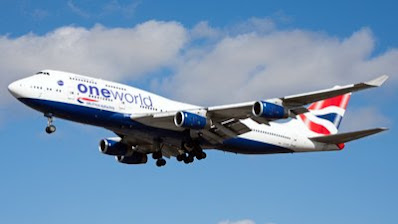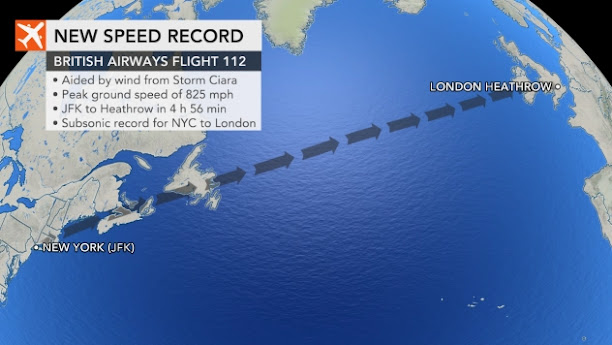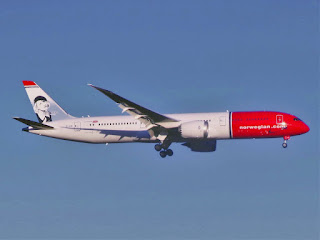British Airways Flight 112 | Transatlantic Speed Record
On February 8, 2020, a British Airways Boeing 747-400 has broken the Transatlantic Speed record. It was flight 112 scheduled to go from New York (JFK) to London (Heathrow).
Flight duration
The flight lasted for 4 hours and 56 minutes. It would normally take up to 7 hours.
How was this possible?
BA 112 made use of the jet stream produced due to storm Ciara and rode it to cross the Atlantic. This helped it in achieving a speed of about 800 miles per hour.
Why didn't it break the sound barrier?
Achieving speeds up to 800 miles per hour would mean that it would have broken the sound barrier creating a sonic boom. The sound barrier wasn't broken because the airplane only had a true airspeed of about 490 knots. The tailwind speed about 250 miles per hour was helping it gain 800 miles per hour. So, it means that the aircraft will not break the sound barrier.
Significance of this flight
Riding a jet stream helped to reduce the flight time significantly. It also helped to save a lot of fuel.
Earlier record
Previously, the transatlantic speed record was borne by Norwegian Airlines with their 787-9 Dreamliner. It was later broken by BA 112 arriving earlier by 17 minutes.
Later attempt to break the record
An attempt was made to beat the record set by BA 112 by a more modern plane, the Airbus A350-1000 belonging to Virgin Atlantic. It was on the verge to set a new record but arrived 1 minute late than BA 112.
Dangers of flying with jet streams
Jet stream's airflow is quite rough. This means that flying inside jet streams would cause turbulence. This would cause discomfort for the passengers. The crew on BA 112 were very cautious and were well-trained and experienced 747 pilots.
British Airways' concern
British Airways said that they were more concerned with the safety of the passengers rather than breaking speed records. It chose the best-trained 747 pilots in its team for this unique flight.
Human Flight | How is It Possible ? | Only Vehicle
The Delhi Sultanate - Only Knowledged
Interesting Mechanics Of Jet Flights:
It has already been stressed that bodies tend to continue within the same state of motion, which this involves direction additionally as speed.
it's clear, therefore, that if we have a tendency to would like to create a body amendment its motion by turning a corner or travelling on a curvilineal path, we have a tendency to should apply a force thereto so as to create it do so, which this may apply although the speed of the body doesn't amendment.
This is a force precisely kind of like the one that's needed to accelerate associate craft, that is to say: the force should be proportional to the mass of the body and to the acceleration that it's desired to supply. however what's the acceleration of a body that's going spherical a corner?
Is there, in fact, any acceleration in the least if the speed remains constant? And in what direction is that the acceleration? Let us handle the last question 1st. there's another a part of Newton’s second law that has not up to now been mentioned, specifically that the speed of change of momentum of the body are going to be within the direction of the applied force.
If the mass of the body doesn't amendment because it goes around the corner the acceleration should be within the direction of the force.
However is there any acceleration if the speed doesn't change? affirmative – as a result of speed is what we have a tendency to decision a vector amount, that's to mention, it's each magnitude and direction, whereas speed has solely magnitude.
Therefore if the direction of motion changes, the rate changes even though the speed remains unaltered .
However at what rate will the rate change? – in different words, what's the acceleration? and in what direction is it?
We all recognize the direction of the force as a results of sensible expertise. Swing
a stone spherical on the tip of a bit of string.
In what direction will the string pull on the stone to stay it on its circular path? Why, towards the center of the circle, of course, and since force and acceleration are within the same direction, the acceleration should even be towards the center.
The vanguard of airfoils employed in subsonic applications is rounded, with a radius that's of the order of 1 Chronicles of the chord length.
The leading-edge radius of the aerofoil section is that the radius of a circle centered on a line tangent to the vanguard camber connecting tangent points of the higher and also the lower surfaces with the vanguard.
The magnitude of the leading-edge radius contains a important result on the stall (or boundary-layer separation) characteristics of the aerofoil section.
The chord line is outlined because the line connecting the
leading and trailing edges. the middle of the leading-edge radius is found such the cambered section comes slightly forward of the leading-edge purpose.
The geometric angle of attack is that the angle between the chord line and also the direction of the undisturbed, “free-stream” flow.
For many airplanes the chord lines of the aerofoil sections ar inclined relative to the vehicle axis.










0 Comments